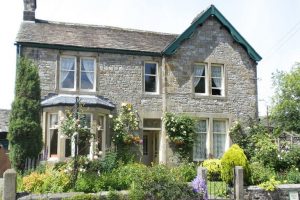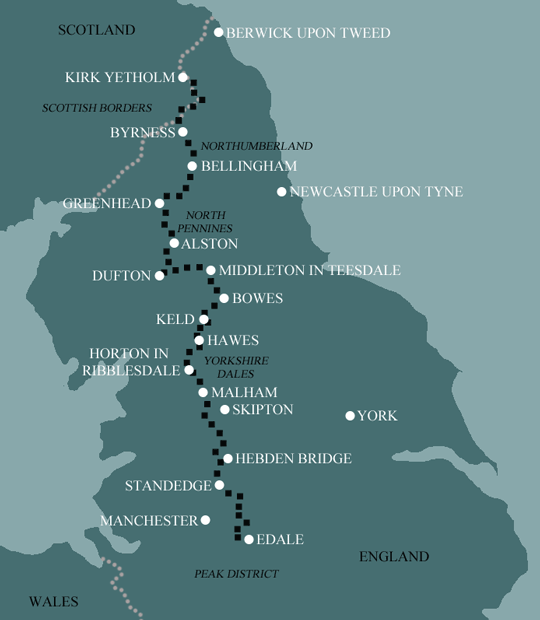Pennine Way Central: Horton in Ribblesdale to Greenhead
Horton in Ribblesdale to Greenhead in 7 Days Walking Code: PWC8
This central section is the wild heart of the Pennine Way. It includes the limestone scenery around Horton, the remote beauty of Swaledale and Teesdale, and the windswept moors beyond. Choose from 4 itineraries, with the option to follow the direct route over Cotherstone Moor or take the gentler Bowes Loop. However you walk it, this is an immersive stretch of high fells, deep valleys, and remote moorland.
This 7 day itinerary is another challenging walk. Although it utilises the Bowes Loop, taking an extra day to reach Middleton-in-Teesdale, the final 3 lengthy days match those of the 6 day option.
| Miles | Km | ||
|---|---|---|---|
| Day 1 | Travel to Horton in Ribblesdale for your first nights accommodation | ||
| Day 2 | Horton in Ribblesdale to Hawes | 14 | 23 |
| Day 3 | Hawes to Keld | 13 | 21 |
| Day 4 | Keld to Bowes | 13 | 21 |
| Day 5 | Bowes to Middleton-in-Teesdale | 12 | 19 |
| Day 6 | Middleton-in-Teesdale to Dufton then transfer to Appleby | 20 | 32 |
| Day 7 | Transfer back to Dufton then walk to Alston | 19 | 31 |
| Day 8 | Alston to Greenhead | 17 | 27 |
| Day 9 | Depart from Greenhead after breakfast |
Horton in Ribblesdale to Hawes
The central section of the Pennine Way begins with a climb out of the village along the narrow Harbour Scar Lane, one of several walled packhorse trails on this opening section. These stony tracks were used for centuries as thoroughfares over the dramatic limestone moors.
Where there is limestone there are pot holes, with Sell Gill Holes being a fine example as the water from Sell Gill Beck suddenly disappears off into the ground.
The landscape around here, characterised by limestone scars, ravines and dried river beds is known as ‘Karst’, a geographical term derived from Slovenia. One such ravine, Ling Gill, protects significant native tree species. Beyond Ling Gill Bridge the trail heads out onto the open expanse of Cam Fell with the reward of fine views to each of the Yorkshire Three Peaks as well as Ribblehead Viaduct.
Next comes Oughtershaw Side where the trail joins West Cam Road above the luscious green valley of Snaizeholme. Surrounded by hills and a huge sky the path unravels easily and the moorland walking down into Hawes is both easy and enjoyable.
Hawes to Keld
With the limestone of the southern Dales behind, the trail will, for a time at least, return to the peat landscapes navigated on the early sections of the southern stretch of the Way, but not before an enjoyable stroll through Wensleydale, out of Hawes. Here you will cross hay meadows that in early summer will be brimming with wildflowers.
If you’re walking following a spell of heavy rain you may be tempted to visit the impressive Hardraw Force, access is through the Green Dragon Inn at Hardraw. This little detour is a temporary distraction from the reality of what lies ahead, the 4.5 mile ascent of Great Shunner Fell. Standing at 2349 feet this is Yorkshire’s third highest mountain.
The walk off Great Shunner Fell down into the village of Thwaite is fairly gentle, and greatly appreciated ahead of the next climb, out of the village, up the steep slopes of Kisdon Hill. The path around Kisdon to the head of Swaledale is marvelous, and provides stunning views into Swinner Gill and onto East Stonedale Moor. All too soon you arrive in Keld.
Keld to Middleton-in-Teesdale
Leaving Keld the trail heads in the direction of the Tan Hill Inn, which at 1732 feet above sea level is Britain’s highest public house. Initially the path runs along a narrow lane between walls, similar to the walk out of Horton, before opening to a wide, peat cushioned path skirting Stonesdale Moor.
After Tan Hill the trail drops down to cross Sleightholme Moor which has the potential to be the wettest stretch of the Way so far. Following prolonged rain the peaty path can become saturated leaving you with little choice but to leap across the peat groughs in an effort to keep your boots dry. Good luck!
Beyond Sleightholme Farm the trail splits in two, later to rejoin at Baldersdale.
The direct route heads over Wytham Moor, dropping down to meet the natural stone span of God’s Bridge before passing beneath the A66 trunk road via an incredibly helpful subway. Here begins a steady ascent out of Stainmore Gap, before taking an undulating course over Cotherstone Moor to Baldersdale enjoying tremendous views ahead to Lunedale and the hills beyond Weardale.
The Bowes Loop, as the name suggests, visits the town of Bowes. Although it adds a good 4 miles to the overall length of the trail, it does have the advantage of accommodating a fairly comfortable 13 mile day from Keld, followed by an equally comfortable 12 miles on to Middleton-in-Teesdale. The direct route links Keld and Middleton-in-Teesdale in one really quite demanding 21 mile day.
The Bowes Loop also benefits from a somewhat drier path, avoiding Cotherstone Moor. The rock formations at Goldsborough provide additional interest to this section of the trail.
Returning to a single trail at Baldersdale the Way passes between Balderhead Reservoir and Blackton Reservoir and soon after, between Selset Reservoir and Grassholme Reservoir. You’re now at the halfway point on the Pennine Way, but there’s still work to be done to reach Middleton-in-Teesdale which lies 7 miles and nearly 10,000 feet of ascent away over Mickleton Moor and Harter Fell.
Middleton-in-Teesdale to Dufton
This is arguably the most impressive stretch of the Pennine Way, culminating in one of the finest sights in England. Furthermore, if you like waterfalls, you’re going to thoroughly enjoy this section of the trail. Given that the Pennine Way is a linear south to north walk, this section is also a bit of an oddity as it finishes further south than it begins!
Following the Tees the trail leads to Low Force, an impressive double waterfall. Beyond Low Force the river becomes both wider and faster, spilling over a spectacular 70 feet drop at the magnificent High Force. The trail then winds its way between rising cliffs at Cronkley Scar and Falcon Clints to reach the huge waterfall of Cauldron Snout, fed by Cow Green Reservoir.
Beyond the reservoir the Way briefly follows the access road to the isolated farmstead of Birkdale, before breaking out on the open moors again by Rasp Hill with its long-abandoned mine workings.
The walk through the open valley of Maize Beck is a delightful experience, yet it pales in comparison to the true highlight of the day, and perhaps the entire Pennine Way; High Cup Nick. Suddenly, a breathtaking sight unfolds as the land drops away before you, revealing a classic U-shaped example of glacial erosion. The valley’s sides are a mix of hard rock, jumbled scree and shimmering rivulets. This remarkable scooped-out bowl exemplifies glacial erosion in all its splendor, a genuine feast for the eyes. Take your time to savour the view in the knowledge that Dufton lies just 4 easy miles away along an old miner’s track.
Dufton to Alston
The main challenge on this section of the trail is scaling Cross Fell. At 2930 feet above sea level it’s the highest point on the Pennine Way. Starting out from Dufton at a mere 600 feet, be ready for a considerable climb. Ensure you’re well-prepared, this is a proper mountain walk. It deserves to be taken seriously.
The official route skirts the edge of Dufton, taking a narrow path between fields on the outskirts of the village. However, many walkers prefer using the unofficial route through the village and along a quiet lane until both paths merge near Coatsyke Farm. From there, a track leads to the ruins of Halsteads and the final gate to open country.
The ascent begins gently, but the gradient increases significantly after crossing the ladder stile over the last access wall.
Over the next couple of miles, as you ascend Knock Fell, you’ll cover almost 1500 feet of the total ascent on this section. Weather permitting, the white dome of the radar station on Great Dun Fell will be your next target, however, in misty conditions, do refer to your map and compass at regular intervals to find the route off Knock Fell.
After two more ascents and a few additional miles, you’ll reach the summit of Cross Fell, the roof of the Pennines, where hopefully a breathtaking panorama awaits. Descending from the summit may not be obvious in mist, so again ensure you refer to your map and compass.
Once safely down to Garrigill all that remains are a final few miles along the river to Alston.
Alston to Greenhead
This stretch of the trail marks the end of the Pennine Chain and the steady transition to the Southern Upland range beyond Hadrian’s Wall. Although less demanding than the previous leg, it still serves up a few challenges.
The first settlement encountered is the tiny hamlet of Slaggyford, nestled beneath Williamston Common. Soon after comes Burnstones Farm where the Pennine Way joins the Maiden Way, an old Roman Road that served Hadrian’s Wall.
Enjoy the firm footing here, because once you pass Greenriggs Farm and reach Blenkinsopp Common things become a little more of a challenge as you enter what could prove to be wettest stretch of your Pennine Way experience. Even after months of drought the likelihood is you will still end up with wet feet here.
The final squelchy challenge of the day is Black Hill. The one crossed in the early part of the southern section of the trail had been tamed with slabs, this Black Hill hasn’t.
Eventually a good track leads to the A69 where after a careful crossing you will walk down into Greenhead village and the completion of the central section of the Pennine Way.
Challenging
As with the southern stretch, all but seasoned walkers will find the central section of the Pennine Way to be an incredibly challenging walk at times. There are some lengthy days, often crossing remote and boggy moorland, as well as an ascent of the highest of the Pennine hills where low cloud and high winds can hamper progress. However, well prepared walkers with experience using a map and compass will relish the challenge and find the experience of walking Britain’s oldest National Trail enormously rewarding.
Terrain: A combination of open moorland, several big hills with long climbs, limestone pavement, pastures, and stony tracks.
What’s it like underfoot? The central section doesn’t benefit from the stone slabs found on the early part of the southern stretch, therefore when crossing moorland there is some pretty wet ground to navigate in places. Things are initially drier under foot walking the last of the limestone pavement in the Dales and the routes on and off the higher hills are firm enough.
How Much Up & Down? Quite a lot. Although the moorland tends to be undulating rather than hilly, there are one or two stiff climbs as well as some long, steady ascents to take into consideration. There is also the matter of Cross Fell. At 2930 feet above sea level it’s the highest point on the Pennine Way. Starting out from Dufton at a mere 600 feet, be ready for a considerable climb
Signposting: Sign posts will usually include the words Pennine Way, along with the National Trail acorn symbol. Occasionally, posts will have the initials PW carved or painted onto them. There may also be markers for other routes such as the Dales Way or Herriot Way. Take time to ensure you are following the correct markers.
Navigation: Providing you familiarise yourself with the route beforehand and you have experience using a map and compass, it should be straightforward. The guidebook is incredibly detailed and we supply two 1:40k Harvey Maps clearly showing the route. As a note of caution there are a number of other routes crossing paths with the Pennine Way and at times sharing paths. Take time to ensure you are following the correct markers. Refer to your guidebook and map at regular intervals, especially during poor weather. Moorland can quickly become bleak and featureless in low cloud.
Weather: Fingers crossed you will experience dry, warm weather throughout your holiday and enjoy dry paths and tremendous views, but you must be prepared because the weather can change quickly, especially on moorland and over high ground. Cross Fell, the highest point on the Pennine Way is prone to high winds. Good clothing, comfortable footwear and reliable waterproofs are essential. It is important you carry plenty of water on warm days. Pack your floppy hat and sun cream also!
|
All Holidays
|
|
| Accommodation | Overnight Bed and Breakfast accommodation in selected hotels, farmhouses, village inns, guest houses and family B&Bs. Cooked or Continental breakfast. |
| Guidebook | A detailed guidebook with route information, maps, photos and background information. |
| Information of Services Along the Route | A comprehensive Service Info sheet, including services such as cash points, banks, post offices, village shops, inns, cafes and taxis. |
| Maps | Two waterproof (1:40,000) Harvey Maps covering the whole of the Pennine Way. |
| Personal Itinerary | A personal itinerary setting out each overnight stop, including large scale maps of each accommodation, to ensure you find it easily. |
| Emergency Telephone Support | If you get in to difficulties during your holiday, we are always available to help, even out of office hours. |
|
Options
|
|
| Luggage Transport | We will transfer your luggage between each overnight stop – if you leave your luggage at the accommodation when you set off in the morning, it will be moved on to your next B&B. You only need to carry a small day sack with the clothes and provisions you require during the day’s walk. |
| Packed Lunches |
Provided for each day’s walking where offered by your host. |
| Off Road Parking | If you are travelling by car we can usually arrange off road parking for the duration of your trip. (There may be a small charge for this). |
| Arrangement of return transport | We can also arrange your transfer back to your car, (or advise you when public transport is a better option)! |
|
What’s not Included
|
|
| Evening Meals | Your evening meal isn’t included in the package, but we include full details and recommendations for each evening meal in your itinerary. You will normally be within walking distance of a pub and/or restaurant, or where there is good food available at the accommodation, we’ll book that for you. Allow about £20.00 per night. |
| Transport to the Start & Away from the Finish | Have a look at the “Travel Info” tab above for suggestions. If you’re still struggling, get in touch and we’ll help you sort it out. |
| Travel Insurance | Even if you are based in the UK travel insurance is worth having. |
Good accommodation and friendly hosts are an essential part of any holiday. We understand this and go out of our way to find the best. We put a great deal of effort into hand picking our accommodation and matching it to individual customer requirements. As well as visiting the accommodation ourselves, we ask all our customers to complete a short evaluation on each night’s accommodation, which then gives us an insight into the day-to-day operation and lets us spot any potential issues before they become a problem.
In selecting the accommodation we look for helpful, friendly hosts with good quality, characterful accommodation close to the trail. We use a variety of accommodation on the Pennine Way. Over the course of your trip you might stay in a village inn, a bed and breakfast in a converted barn, a Victorian guest house, or on a working farm. Occasionally we may use a chain hotel. In more remote locations you will have the opportunity to dine with your hosts and alongside fellow walkers.
We always try to arrange en suite accommodation, i.e. rooms with their own bathrooms for each night of your stay. However, in some of the more remote locations accommodation is limited and occasionally we may have to book rooms with shared bathrooms for one or two nights of your holiday, (especially if the booking is made at short notice), but we will always let you know if this is likely to be the case.
We are happy to book single rooms on our holidays but cannot normally book more than two for any one group. Single room bookings include a supplement.
Here are some of examples of the accommodation we use on the Pennine Way:
 Situated in the delightful Saddleworth village of Delph is The Old Bell Inn, an 18 bedroomed, four star AA and Visit England accredited Inn. This splendid 18th century listed Coaching House is rich in history and has been thoughtfully transformed to reflect a blend of traditional old English warmth with contemporary luxury. Visit their website
Situated in the delightful Saddleworth village of Delph is The Old Bell Inn, an 18 bedroomed, four star AA and Visit England accredited Inn. This splendid 18th century listed Coaching House is rich in history and has been thoughtfully transformed to reflect a blend of traditional old English warmth with contemporary luxury. Visit their website
 In the charming village of Haworth Josie and Brendan welcome you to their stunning guesthouse. Thoughtfully renovated; celebrating the past but with a nod to the future, Weavers of Haworth offers a stylish and snug place to stay in the heart of Haworth. An ideal location from which to explore Brontë country. Visit their website
In the charming village of Haworth Josie and Brendan welcome you to their stunning guesthouse. Thoughtfully renovated; celebrating the past but with a nod to the future, Weavers of Haworth offers a stylish and snug place to stay in the heart of Haworth. An ideal location from which to explore Brontë country. Visit their website
 Located in the picturesque village of Malham is River House, a charming property dating back to 1664. River House has 8 individually decorated bedrooms, with lovely homely touches. Alex and Ann have been welcoming walkers for almost 20 years and setting them up for the day ahead with a delicious Yorkshire Dales Aga cooked breakfast. Visit their website
Located in the picturesque village of Malham is River House, a charming property dating back to 1664. River House has 8 individually decorated bedrooms, with lovely homely touches. Alex and Ann have been welcoming walkers for almost 20 years and setting them up for the day ahead with a delicious Yorkshire Dales Aga cooked breakfast. Visit their website
 Marco and Jillian are your hosts at Broad Croft House B&B in Horton in Ribblesdale. Their cosy, family-run Bed and Breakfast has a stunning view of Pen-y-ghent, one of the Yorkshire Three Peaks. Comfortable rooms, beautifully decorated, and a spacious garden make Broad Croft the perfect place for a relaxing stay. Visit their website
Marco and Jillian are your hosts at Broad Croft House B&B in Horton in Ribblesdale. Their cosy, family-run Bed and Breakfast has a stunning view of Pen-y-ghent, one of the Yorkshire Three Peaks. Comfortable rooms, beautifully decorated, and a spacious garden make Broad Croft the perfect place for a relaxing stay. Visit their website
 Andrew assures you of a warm welcome at Brunswick House in Middleton in Teesdale. You will enjoy a relaxed homely environment whilst receiving a professional standard of hotel service and customer care. This delightful house boasts Georgian fireplaces and exposed beams whilst incorporating all modern conveniences. Visit their website
Andrew assures you of a warm welcome at Brunswick House in Middleton in Teesdale. You will enjoy a relaxed homely environment whilst receiving a professional standard of hotel service and customer care. This delightful house boasts Georgian fireplaces and exposed beams whilst incorporating all modern conveniences. Visit their website
 Laura and Oli are your hosts at Forest View Walkers Inn at Byrness. You will spend two nights at this ‘special place in the forest’ enjoying their delicious home cooked food in a friendly communal setting. Staying at Forrest View splits the lengthy Cheviots section over two days with Oli picking you up from, and dropping you back on, the trail. Visit their website
Laura and Oli are your hosts at Forest View Walkers Inn at Byrness. You will spend two nights at this ‘special place in the forest’ enjoying their delicious home cooked food in a friendly communal setting. Staying at Forrest View splits the lengthy Cheviots section over two days with Oli picking you up from, and dropping you back on, the trail. Visit their website
General travel information for the Pennine Way Central will be in your holiday pack.
Detailed instructions on getting to your first night’s accommodation by car, or on foot from the nearest train or bus station, will also be included in the holiday pack on individual accommodation maps.
To view train times please visit trainline where you can also purchase tickets in advance. For information on bus timetables please visit traveline
Getting to Horton in Ribblesdale:
By Air: The nearest International Airports to the trail are Leeds Bradford Airport and Manchester. Shuttlebus services run between the Airport and both Leeds Railway Station and Bradford Forster Square Station. Trains run direct between both stations and Horton in Ribblesdale.
If travelling via Manchester Airport, there is a railway station at the Airport with hourly trains to Horton in Ribblesdale via Leeds.
By Public Transport: Horton in Ribblesdale Railway Station is located on the Settle to Carlisle Line with connections at Carlisle to the West Coast Main Line between Glasgow and London Euston. Despite its name, the line actually continues southwards from Settle to terminate at Leeds where it connects with the East Coast Main Line between Edinburgh and London Kings Cross. Trains also run directly between Leeds and Manchester.
By Road: Horton in Ribblesdale is located on the B6479, approximately 15 minutes off the A65 via Settle.
From the M6: Leave at Junction 36 (A65 Kirkby Lonsdale & Skipton).
From the A1(M): Leave at Junction 47, follow signs for the A59 and continue to Skipton, where it meets and merges with the A65.
Returning from Greenhead:
By Public Transport: The nearest railway station to Greenhead is Haltwhistle. Haltwhistle station is also located on the Tyne Valley Line with fast and frequent connections to the West Coast Mainline at Carlisle and the East Coast Mainline at Newcastle Central.
By Road: Greenhead is located on the B6318, just off the A69 road between Carlisle and Newcastle.
From the M6: Leave at Junction 43 and follow signs for the A69 Newcastle, Hexham and Brampton.
From the A1: Leave at East Denton following signs for the A69 Hexham.
Horton in Ribblesdale
Having scaled Pen-y-ghent when walking from Malham into Horton in Ribblesdale, why not add an additional day to ascend one of the other iconic Yorkshire Three Peaks. Choose from Ingleborough or Whernside, or indeed both?
Ingleborough is easily accessible from Horton in Ribblesdale, while a ten minute train ride round to the Ribblehead will have you best positioned for Whernside, or an Ingleborough and Whernside combination.
Hawes
Hawes is a bustling market town, lying in the heart of the Yorkshire Dales National Park and surrounded by spectacular scenery. With many craft workshops, antique and speciality shops and restaurants on offer, it’s the perfect place to spend a well-earned rest day. This picturesque town is home to the famous Wensleydale Cheese and the renowned Dales country side museum.
| Prices | GBP (£) |
|---|---|
| Accommodation, map & guidebook only | £957 |
| with Luggage Transport | £1195 |
| with Packed Lunches | £1037 |
| with Luggage & Lunches | £1265 |
Other Options |
|
| Extra Nights (per night) | £95 |
| Single Supplement (per night) | £63 |
| Solo Luggage Supplement (per day) | £17 |
